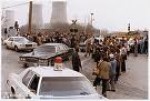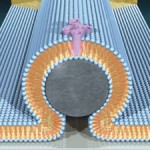Nuclear’s Preparedness Lessons
Posted on June 29, 2010
Filed Under Business, Technology | Leave a Comment
 Like all of you, I’ve been watching with increasing dismay the gulf oil fiasco. Amid the scenes of gushing crude, oil-soaked birds, and iridescent marshes it is easy to forget that good and competent people are working around the clock trying to stop the oil. At some point they will succeed and we can get on with Phase 2: Endless litigation and interminable government hearings. Will any good come from all the Sturm und Drang? If the last such accident of national consequence is any indication, perhaps the answer is yes.
Like all of you, I’ve been watching with increasing dismay the gulf oil fiasco. Amid the scenes of gushing crude, oil-soaked birds, and iridescent marshes it is easy to forget that good and competent people are working around the clock trying to stop the oil. At some point they will succeed and we can get on with Phase 2: Endless litigation and interminable government hearings. Will any good come from all the Sturm und Drang? If the last such accident of national consequence is any indication, perhaps the answer is yes.
After Three Mile Island (TMI) the U.S. nuclear power industry went through all the Kubler-Ross stages:
• Denial: This appears to be much ado about nothing.
• Anger: Dammit… who screwed up, whose fault is this?
• Bargaining: Whoa, slow down with all the proposed regulations…let’s just reason together.
• Depression: This industry is dead; there’s no way we can afford all these new rules and retrofits.
• Acceptance: We’re still America’s best energy hope; we’re going to come back stronger than ever.
 After TMI the nuclear industry did some soul-searching and decided: One more event like this and we are doomed as an industry, so let’s make sure it doesn’t happen again. And many of the innovations that followed TMI have contributed to the industry’s excellent performance and budding renaissance. These include:
After TMI the nuclear industry did some soul-searching and decided: One more event like this and we are doomed as an industry, so let’s make sure it doesn’t happen again. And many of the innovations that followed TMI have contributed to the industry’s excellent performance and budding renaissance. These include:
• Creating the Institute of Nuclear Power Operations to set benchmarks, identify and exchange power plant best practices, and generally pursue operational excellence.
• Creating the World Association of Nuclear Operators to do more or less the same thing across national borders
• Funding ambitious government research projects that investigated exactly how nuclear accidents initiate and progress, including a major initiative on the human factors component
• Conducting large-scale experiments to duplicate the TMI events and learn exactly what happened, down to very subtle chemical effects occurring inside the nuclear fuel
• Nuclear utility competitors pooling their resources to sponsor their own accident prevention research
• New accident detection and prevention technologies mandated for new plants and retrofit into existing plants
Looking at this list, I see a path – after this oil well is capped and the cleanup is behind us – towards a much safer and better run offshore oil industry. Oil will be in our future for all of our lifetimes. Let’s make sure we do it right.
And oh by the way nuclear industry, it’s been 30+ years since TMI. Are you still looking over your shoulder and remembering your 1979 lesson of eternal vigilance? – Dennis Owen
Good Management Requires Empathy Above All
Posted on June 27, 2010
Filed Under Business, Technology | Leave a Comment
Nobody said being a manager is easy. Actually, being a good manager, being relationally successful with colleagues, superiors, customers or communities, can be very demanding. Especially if some of those folks are difficult themselves, which they can be.
So how does a manager prepare himself, or steel herself, for difficult days? This is an especially pertinent question for technologists whose training has been in abstractions and demanding details, not so much in relationships.
 Steve Roesler, a management consultant, makes a notable contribution to understanding what it takes to manage well in his All Things Workplace blog. He writes of the “Five Minds of a Manager”, yes five. But if you can get these traits and techniques in hand, corporate challenges are likely to go better.
Steve Roesler, a management consultant, makes a notable contribution to understanding what it takes to manage well in his All Things Workplace blog. He writes of the “Five Minds of a Manager”, yes five. But if you can get these traits and techniques in hand, corporate challenges are likely to go better.
Steve is actually quoting principles he came upon in an article entitled, uncannily, “Five Minds of a Manager” by Johnathan Gosling and Henry Mitzberg. (What he hasn’t done is provide a link to the piece. But Supermind Google advises that it was in The Harvard Business Review of November, 2003 – wisdom, of course, doesn’t have to be current.)
The five principles, actually “mindsets,” for relating well are what matter and here they are. They are days, we can recall, when we wish we had them all on tap and tuned tight:
1. Reflective mindset
“Stepping back and reflecting on experiences allow mistakes to be identified. Reflection may also lead to seeing things in a new ways, e.g., a product as a service or customers as partners (or vice versa).”
2. Analytical mindset
“Go beyond crunching the numbers. When a decision must be made, analyze the analysis of others to determine the biases they may have had and the data and assumptions used.”
3. Wordly mindset
There are lots of worlds within the world and cultural awareness is crucial.
4. Collaborative mindset
Don’t hole up in your office – get out and mingle with your staff and customers, and listen more than direct.
5. Action mindset
“Managers with action mindsets focus organizational energy on changing what needs to be changed while carefully maintaining what doesn’t.”
Yes, these are all important vantage points. But we might suggest one overarching principle that’s indispensable for successful managing – empathy, walking in someone else’s shoes and identifying with what’s firing them up. Be sure, in other words, to relate well to those shaping your managerial world. – Doug Bedell
Photo – FreeDigialPhotos.net
Japanese Spacecraft Breaks Up Returning From a Billion-Mile Trip
Posted on June 17, 2010
Filed Under Technology | Leave a Comment
The NASA guys keep broadcasting neat things. You hardly ever know when, or who’s listening. But here’s a NASA team video of a Japanese unmanned spacecraft, the Hayabusa, reentering earth’s orbit and breaking up into flaming pieces that the NASA guys think are “beautiful.” Fascinating, yes, but “beautiful” doesn’t seem quite the word for something that’s being destroyed after a trip of 1.25 billion miles.
The video has become a viral hit on YouTube, with well over 200,000 viewers. It was made from a NASA DC-9 airborne laboratory.
The Hayabusa was launched in May, 2003, Mashable advises, to reach the Itokawa comet, “in order to gather samples from the comet and study the astral body’s characteristics, including its topography, trajectory, speed and composition. The spacecraft reached the comet in September 2005.”
When it reached the earth’s atmosphere on its return trip recently, the Hayabusa started breaking up into hundreds of flaming pieces. It was as though it was leaving a punch-tape record across the heavens, and then the tape “caught fire” and disintegrated.
This writer has to refresh himself on why it’s necessary to loose returning unmanned space vehicles like this one. But for now, it’s enough to know that the scientists only needed the canister the Hayabusa had with the samples it collected and they’ve retrieved that from its landing place in South Australia.
So have a look at what’s caused all the excitement at NASA and on YouTube. – Doug Bedell
f
Introducing the New ‘Leaf’
Posted on June 15, 2010
Filed Under Technology | Leave a Comment
We’ve been noting the advent of electric cars. Now here’s a review of one of them, the Nissan Leaf, that, along with the Chevy Volt, is likely to make 2010/11 a landmark time for battery-powered transportation. Both cars are aimed a the mass-market buyers. (One thing we seldom see, however, is discussion of the cost of replacing an electric car’s battery once it wears out. “Buy ’em new,” seems to be the best approach to electric autos.)
 Car magazine reports that Nissan purposely designed the Leaf to look “normal,” and so it does. It’s for urban and suburban use, not speedways, but can hit 90 mph. It has a range of around 100 miles.
Car magazine reports that Nissan purposely designed the Leaf to look “normal,” and so it does. It’s for urban and suburban use, not speedways, but can hit 90 mph. It has a range of around 100 miles.
We love this aspect of the car: It’s quieter than a Rolls Phantom. Up to 15 mph, it has “a muted jet engine whirr,” that’s discernable only to pedestrians – to warn them it’s around.
Here’s more on electric cars from Energy Biz Insider. – Doug Bedell
Machines Becoming Minute Cell Matter
Posted on June 10, 2010
Filed Under Technology | Leave a Comment
Practical uses are still years away, but we’re pleased to note that researchers have found a way to link technology with human cells very closely.
A nano-sized transistor is embedded in a cell-like membrane – “the most intimate binding of man and machine yet achieved.”
 “This device is as close to the seamless marriage of biological and electronic structures as anything else that people did before,” says Aleksandr Noy, a scientist at the University of California. The device is an implanted circuit, beginning with a simple transistor. But instead of using silicon, the most common material in transistors, the researchers “used a next generation material known as a carbon nanotube, a tiny straw-shaped material made from a single curved layer of carbon atoms arranged like the panels of a soccer ball.
“This device is as close to the seamless marriage of biological and electronic structures as anything else that people did before,” says Aleksandr Noy, a scientist at the University of California. The device is an implanted circuit, beginning with a simple transistor. But instead of using silicon, the most common material in transistors, the researchers “used a next generation material known as a carbon nanotube, a tiny straw-shaped material made from a single curved layer of carbon atoms arranged like the panels of a soccer ball.
“The scientists then coated the carbon nanotube transistor with a lipid bilayer, basically a double wall of oil molecules that cells use to separate their insides from their environment.” They did’t use an actual cell membrane, however…
There’s more on the technique in the online article in Discovery News. The bottom line is it may one day be possible to gather information “about the inner workings of disease-related proteins inside the cell membrane, and eventually lead to new ways to read, and even influence, brain or nerve cells.”
This kind of research holds promise for people with bodily ailments, though “any actual treatment is still years away.” Wouldn’t it be great if something like this could be used to restart, say, damaged spinal cells and restore motion in inert muscles?
Whatever eventually results from work like this, the point is that technical ingenuity is being combined in the most intimate way imanginable with building-block bodily structures. Mind and matter are on their way, in given applications at least, to becoming one. – Doug Bedell
– The illustration is an artist’s representation of a new transistor that’s contained within a cell-like membrane. In the core of the device is a silicon nanowire (grey), covered with a lipid bilayer (blue).
Learning from Adversity Should Occur Widely
Posted on June 3, 2010
Filed Under Technology | Leave a Comment
The technological disaster of our time is now the BP oil spill, not the Three Mile Island nuclear power accident 31 years ago or the Challenger rocket explosion in 1986. BP is a real disaster, while TMI (which we’re most familiar with) was only a perceived one. A mere $1 billion was spent cleaning up TMI Unit 2 after the uranium fuel in its reactor vessel partially melted. The damage at TMI-2 was confined to the reactor system and its containment building.
Both of us, Dennis Owen and Doug Bedell, worked at TMI during the Unit 2 cleanup and the restart of TMI-1. Dennis was a recovery engineer at Unit 2 and Doug was TMI’s post-accident communication manager.
The TMI accident effectively shut down construction of new U.S. nuclear plants for 30 years. Plants under construction were allowed to continue, and retrofits were ordered at operating plants once the “stuck-open-valve” malfunction was understood. Similarly, offshore oil rigs now operating should be closely monitored and possibly retrofitted when the problem at BP’s well is understood.
As turned out to be the case at TMI, cultural issues having to do with training and attentiveness – by employees and management alike – are likely at the heart of the BP disaster or, indeed, catastrophe. Why do we keep having to learn such things anew, at such cost?
Whether it was arrogance or ineptitude, not enough attention was paid to operational issues at BP’s oil platform. Newsweek is already making that clear in a gripping article, “Black Water Rising,” in its June 7 issue. A presidential commission will be investigating the accident, like the Kemeny Commission did after the accident at TMI-2.
When the Kemeny report came out, industry generally should have paid enough attention to its findings to avoid another costly accident, anywhere.
The now defunct General Public Utilities Corp., TMI’s owner at the time, was determined to learn all that it could from the Unit 2 accident, very much to its credit. Focusing on the lessons of the accident improved GPU’s corporate culture overall, and a strong, knowledge-imparting culture is essential to avoiding accidents. (Making wrong guesses about the direction of energy prices is perhaps another matter.)
The worst kind of situation at any company is to have the sort of “good ol’ boys” culture that Newsweek describes as having existed at BP and the Interior Department’s Minerals Management Service (MMS). “Oil guys know best” is nothing like having actual awareness of what can go wrong and how.
At TMI-2, the operators were misled early one morning by inadequate signaling on their control panels. They mistook a stuck open valve for an indication that the reactor’s cooling system had too much water when actually it was losing water. Better training as well as a redesigned control room were part of the answer then. But the biggest “gain” from that situation was the simple awareness that unexpected events can happen – to try to avoid them, but to be responsibly ready for them if they occur.
That, and to have effective regulation as well. In nuclear power, the Nuclear Regulatory Commission and its inspectors at the plants keep their distance from the industry, as the MMS folks apparently did not.
After the latest BP accident, President Obama asked Energy Secretary Steven Chu, a Nobel Laureate himself, “to assemble the best minds in America and get them down there.” Some of the best minds in America were assembled for John Kemeny’s commission on TMI-2. The problem is how we learn, and how widely we learn, from disastrous events and the findings they inevitably produce. This applies not only to operational managements but professional and trade societies as well.
NASA likely has the lessons of the Challenger accident seared in its institutional memory, as TMI’s staff and the Nuclear Regulatory Commission no doubt readily recall the Unit 2 accident. Learning from disasters, however, has to occur in a lot wider manner than among those directly involved. Suppose BP had paid attention, close attention, to the Challenger, TMI and, indeed, the Exxon Valdez oil spill. We don’t know whether they did or not, but if they did, it hasn’t been showing. – Doug Bedell
Recently
- Presentations With Forethought
- Technical Writing’s Lineage – Surely It’s Deeper than Digital
- At the Holidays, Twitting Amazon
- Successful Cookie Baking – From Mom, an Acknowledged Expert
- Slides for a Tech Writer’s Craft
- Digital or Not, Be Clear
- Being Watchful About Digital Designs…
- When Proposals Don’t Click, Keep Making Them Anyway
- Like a Good Gardener, Help an Enterprise Keep Itself Current
- We’re Leaders All, And Need to Think That Way
Categories
Archives
- January 2017
- December 2016
- November 2016
- October 2016
- September 2016
- August 2016
- July 2016
- June 2016
- May 2016
- April 2016
- March 2016
- February 2016
- January 2016
- December 2015
- November 2015
- October 2015
- September 2015
- August 2015
- July 2015
- June 2015
- May 2015
- April 2015
- March 2015
- February 2015
- January 2015
- December 2014
- November 2014
- October 2014
- March 2014
- February 2014
- January 2014
- December 2013
- November 2013
- October 2013
- September 2013
- August 2013
- July 2013
- June 2013
- May 2013
- April 2013
- March 2013
- February 2013
- January 2013
- December 2012
- November 2012
- October 2012
- September 2012
- August 2012
- July 2012
- June 2012
- May 2012
- April 2012
- March 2012
- February 2012
- January 2012
- December 2011
- November 2011
- October 2011
- September 2011
- August 2011
- July 2011
- June 2011
- May 2011
- April 2011
- March 2011
- February 2011
- January 2011
- December 2010
- November 2010
- October 2010
- September 2010
- August 2010
- July 2010
- June 2010
- May 2010
- April 2010
- March 2010
- February 2010
- January 2010